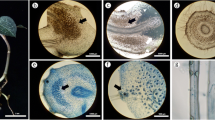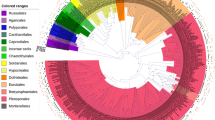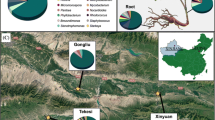Abstract
Common occurrence of testate amoebae (TA) in the rhizosphere of mycorrhizal plants indicates existence of yet undocumented ecological interactions, involving three distinct groups of organisms: soil protists, mycorrhizal fungi, and their host plants. This tripartite relationship was to date investigated only to a limited extent, despite its probable importance for processes taking place in the mycorrhizosphere. In this study, we (1) explored spectra of different TA genera naturally associated with the rhizoplane of three autochthonous European Rhododendron species, (2) screened natural fungal colonization of the TA shells occupying the rhizoplane of selected rhododendrons, and (3) carried out two in vitro experiments addressing the question whether TA shells may serve as a nutrient source for ericoid mycorrhizal fungi (ErMF) and dark septate endophytes (DSE). Our field observations indicated that TA regularly associated with the rhizoplane of all screened rhododendrons and that ErMF and/or DSE associated with their roots possibly exploited the TA shells as a nutrient source. We were unable to detect any major differences among the TA spectra from the rhizoplanes with respect to the three Rhododendron species. The spectra were dominated by Diplochlamys, Centropyxis, Cyclopyxis, Euglypha, Trinema, and Assulina. Positive, neutral, and negative associations were found for various TA genera × Rhododendron species combinations. The highest fungal colonization was observed in Centropyxidae and Trigonopyxidae, reaching up to 45% of the shells in the case of Trigonopyxis. In the in vitro experiments, both ErMF Rhizoscyphus ericae and DSE Phialocephala fortinii regularly colonized TA shells, utilizing them as a source of nutrients. We hypothesize a complex relationship between ErMF–DSE and TA. If corroborated, it would represent an interesting nutrient loop in the mycorrhizosphere of ericaceous plants.



Similar content being viewed by others
References
Alekperov I, Snegovaya N (2000) The fauna of testate amoebae (Rhizopoda, Testacea) in freshwater basins of Apsheron peninsula. Protistology 1:135–147
Aoki Y, Hoshino M, Matsubara T (2007) Silica and testate amoebae in a soil under pine-oak forest. Geoderma 142:29–35
Bajwa R, Read DJ (1985) The biology of mycorrhiza in the Ericaceae: IX. Peptides as nitrogen sources for mycorrhizal and non-mycorrhizal plants. New Phytol 101:459–467
Bajwa R, Abuarghub S, Read DJ (1985) The biology of mycorrhiza in the Ericaceae. X. The utilization of proteins and the production of proteolytic enzymes by mycorrhizal plants. New Phytol 101:469–486
Baláž M, Vosátka M (2001) A novel inserted membrane technique for studies of mycorrhizal extraradical mycelium. Mycorrhiza 11:291–296
Balík V (1990) Zur Kenntnis der Bodentestaceen (Rhizopoda: Testacea) Südböhmens. Act Mus Boh Meridion in Č. Budějovice 30:1–12 [in Czech with German summary]
Balík V (1992a) Krytenky (Rhizopoda, Testacea) z několika lokalit z chráněné krajinné oblasti Beskydy (Severní Morava, ČSFR). Čas Slez Muz Opava 41:31–40 [in Czech with English summary]
Balík V (1992b) Testate amoebae fauna (Protozoa, Rhizopoda, Testacea) from the marsh habitats in the Krkonoše Mountains National Park (Czechoslovakia). Opera Corcontica 29:139–154 [in Czech with English summary]
Balík V (1992c) Die Testaceen (Rhizopoda, Testacea) aus dem Naturschutzgebiet Trojmezná hora im Böhmerwald (Tschechoslowakei). Act Mus Boh Meridion in Č. Budějovice 32:69–78 [in Czech with German summary]
Balík V (1994) Testaceenfauna (Protozoa, Rhizopoda, Testacea) aus dem Naturschutzgebiet Žofínský prales (Novohradské hory Gebirge) in Südböhmen (Tschechische Republik). Act Mus Boh Meridion in Č. Budějovice 34:55–67 [in Czech with German summary]
Balík V (1997) Fauna krytenek (Protozoa, Testacea) západní části Tatranského Národního Parku (Slovenská Republika). Štúdie o Tatranskom Národnom Parku 2:103–122 [in Czech]
Bartoš E (1954) Koreňonožce radu Testacea. Vydavaťelstvo Slovenskej Akadémie Vied, Bratislava, pp 1–185 [in Slovak]
Bonkowski M (2004) Protozoa and plant growth: the microbial loop in soil revisited. New Phytol 162:617–631
Bonkowski M, Cheng W, Griffiths BS, Alphei J, Scheu S (2000) Microbial–faunal interactions in the rhizosphere and effects on plant growth. Eur J Soil Biol 36:135–147
Bonkowski M, Jentschke G, Scheu S (2001) Contrasting effects of microbial partners in the rhizosphere: interactions between Norway Spruce seedlings (Picea abies Karst.), mycorrhiza (Paxillus involutus (Batsch) Fr.) and naked amoebae (protozoa). Appl Soil Ecol 18:193–204
Brundrett M, Bougher N, Dell B, Grove T, Malajczuk N (1996) Working with mycorrhizas in forestry and agriculture. ACIAR Monograph 32. ACIAR, Canberra, p 374
Cairney JWG, Meharg AA (2003) Ericoid mycorrhiza: a partnership that exploits harsh edaphic conditions. Eur J Soil Sci 54:735–740
Coûteaux M-M (1985) Relationships between testate amoebae and fungi in humus microcosms. Soil Biol Biochem 17:339–345
Coûteaux M-M, Darbyshire JF (1998) Functional diversity amongst soil protozoa. Appl Soil Ecol 10:229–237
Cross JR (1975) Rhododendron ponticum L. J Ecol 63:345–364
Deflandre G (1929) Le genre Centropyxis Stein. Archiv für Protistenkunde 67:322–375 [in French]
Deflandre G (1936) Etude monographique sur le genre Nebela Leidy. Annales de Protistologie 5:201–286 [in French]
Fitter AH, Garbaye J (1994) Interactions between mycorrhizal fungi and other soil organisms. Plant Soil 159:123–132
Foissner W (1987) Soil protozoa: fundamental problems, ecological significance, adaptations in Ciliates and Testaceans, bioindicators, and guide to the literature. Prog Protistol 2:69–212
Foissner W, Korganova GA (2000) The Centropyxis aerophila complex (Protozoa: Testacea). Acta Protozool 39:257–273
Gilbert D, Amblard C, Bourdier G, Francez A-J (1998a) The microbial loop at the surface of a peatland: structure, function, and impact of nutrient input. Microb Ecol 35:83–93
Gilbert D, Amblard C, Bourdier G, Francez A-J (1998b) Short-term effect of nitrogen enrichment on the microbial communities of a peatland. Hydrobiologia 373–374:111–119
Gilbert D, Mitchell EAD, Amblard C, Bourdier G, Francez A-J (2003) Population dynamics and food preferences of the testate amoeba Nebela tincta major-bohemica-collaris complex (Protozoa) in a Sphagnum peatland. Acta Protozool 42:99–104
Grünig CR, McDonald BA, Sieber TN, Rogers SO, Holdenrieder O (2004) Evidence for subdivision of the root-endophyte Phialocephala fortinii into cryptic species and recombination within species. Fungal Genet Biol 41:676–687
Hammer R, Harper DAT, Ryan PD (2001) PAST: Palaeontological Statistics software package for education and data analysis. Palaeontol Electronica 4:9
Hedley RH (1963) Cement and iron in the arenaceous foraminifera. Micropaleontology 9:433–441
Ingham ER, Massicotte HB (1994) Protozoan communities around conifer roots colonized by ectomycorrhizal fungi. Mycorrhiza 5:53–61
Jaccard P (1908) Nouvelles recherches sur la distribution florale. Bull Soc Vaud Sci Nat 44:223–270 [in French]
Joyon L, Charret R (1962) Sur l’ultrastructure du Thécamoebien Hyalosphenia papilo (Leidy). C R Acad Sci 255:2661–2663 [in French]
Jumpponen A (2001) Dark septate endophytes—are they mycorrhizal? Mycorrhiza 11:207–211
Jumpponen A, Trappe JM (1998) Dark septate endophytes: a review of facultative biotrophic root-colonizing fungi. New Phytol 140:295–310
Kerley SJ, Read DJ (1995) The biology of mycorrhiza in the Ericaceae. XVIII. Chitin degradation by Hymenoscyphus ericae and transfer of chitin–nitrogen to the host plant. New Phytol 131:369–375
Kerley SJ, Read DJ (1997) The biology of mycorrhiza in the Ericaceae. XIX. Fungal mycelium as a nitrogen source for the ericoid mycorrhizal fungus Hymenoscyphus ericae and its host plant. New Phytol 136:691–701
Kerley SJ, Read DJ (1998) The biology of mycorrhiza in the Ericaceae. XX. Plant and mycorrhizal necromass as nitrogenous substrates for ericoid mycorrhizal fungus Hymenoscyphus ericae and its host. New Phytol 139:353–360
Klironomos JN, Hart MM (2001) Animal nitrogen swap for plant carbon. Nature 410:651–652
Mandyam K, Jumpponen A (2005) Seeking the elusive function of the root-colonising dark septate endophytic fungi. Stud Mycol 53:173–189
Mitchell EAD, Charman DJ, Warner BG (2008) Testate amoebae analysis in ecological and paleoecological studies of wetlands: past, present and future. Biodivers Conserv doi:10.1007/s10531-007-9221-3
Morcazewski J (1961) Testacea du littoral peu profound du lac Kisajno (Region des lacs de Mazurie). Polskie Archiwum Hydrobiol 9:175–194 [in Polish and French]
Morisita M (1959) Measuring the dispersion of individuals and analysis of the distributional patterns. Mem Fac Sci Kyushu Univ Ser E (Biol) 2:215–233
Nilsen ET, Walker JF, Miller OK, Semones SW, Lei TT, Clinton BD (1999) Inhibition of seedling survival under Rhododendron maximum (Ericaceae): could allelopathy be a cause? Am J Bot 86:1597–1605
Ogden CG, Hedley RH (1980) An atlas of freshwater testate amoebae. Oxford University Press, Oxford, p 222
Patterson RT, Dalby A, Kumar A, Henderson LA, Boudreau EA (2002) Arcellaceans (thecamoebians) as indicators of land-use change: settlement history of the Swan Lake area, Ontario as a case study. J Paleolimn 28:297–316
Pearson V, Read DJ (1973) The biology of mycorrhiza in the Ericaceae. I. The isolation of the endophyte and synthesis of mycorrhiza in aseptic culture. New Phytol 72:371–379
Read DJ (1996) The structure and function of the ericoid mycorrhizal root. Ann Bot 77:365–374
Read DJ, Perez-Moreno J (2003) Mycorrhizas and nutrient cycling in ecosystems—a journey towards relevance? New Phytol 157:475–492
Read DJ, Leake JR, Perez-Moreno J (2004) Mycorrhizal fungi as drivers of ecosystem processes in heathland and boreal forest biomes. Can J Bot 82:1243–1263
Real R, Vargas JM (1996) The probabilistic basis of Jaccard’s index of similarity. Syst Biol 45:380–385
Rydlová J, Vosátka M (2000) Sporulation of symbiotic arbuscular mycorrhizal fungi inside dead seeds of a non-host plant. Symbiosis 29:231–248
Rydlová J, Batkhuugyin E, Vosátka M (2004) Sporulation of four arbuscular mycorrhizal fungi isolates inside dead seed cavities and glass capillaries. Symbiosis 36:269–284
Schröter D, Brussaard L, De Deyn G, Poveda K, Brown VK, Berg MP, Wardle DA, Moore J, Wall DH (2004) Trophic interactions in a changing world: modelling aboveground–belowground interactions. Basic Appl Ecol 5:515–528
Smith SE, Read DJ (1997) Mycorrhizal Symbiosis, 2nd edn. Academic, London, pp 323–345
Sutton CA, Wilkinson DM (2007) The effects of Rhododendron on testate amoebae communities in woodland soils in North West England. Acta Protozool 46:333–338
Vargas R (1990) Avances en microbiologia de suelos: los protozoarios y su importancia en la mineralizacion del nitrogeno. Agronomía Costarricense 14(1):121–134 [in Spanish]
Vohník M, Lukančič S, Bahor E, Regvar M, Vosátka M, Vodnik D (2003) Inoculation of Rhododendron cv. Belle-Heller with two strains of Phialocephala fortinii in two different substrates. Folia Geobotanica 38:191–200
Vohník M, Albrechtová J, Vosátka M (2005) The inoculation with Oidiodendron maius and Phialocephala fortinii alters phosphorus and nitrogen uptake, foliar C:N ratio and root biomass distribution in Rhododendron cv. Azurro. Symbiosis 40:87–96
Vohník M, Fendrych M, Albrechtová J, Vosátka M (2007) Intracellular colonization of Rhododendron and Vaccinium roots by Cenococcum geophilum, Geomyces pannorum and Meliniomyces variabilis. Folia Microbiologica 52:407–414
Acknowledgments
This study was supported by the Academy of Sciences of the Czech Republic (research projects AV0Z60050516 and AV0Z50110509) and Ministry of Education, Youth, and Sports of the Czech Republic (research program LC06063). M. Vohník was financially supported by the Grant Agency of the Czech Republic (GACR 206/03/H137). The authors thank Dominik Vodnik, Simon Lukančič, and Matyáš Fendrych for help with collection of the environmental samples, Vladimír Balík and Alena Kubátová for useful information at the beginning of the work and Edward A. D. Mitchell, David M. Wilkinson, and anonymous reviewers for valuable comments on earlier versions of the manuscript.
Author information
Authors and Affiliations
Corresponding author
Rights and permissions
About this article
Cite this article
Vohník, M., Burdíková, Z., Albrechtová, J. et al. Testate Amoebae (Arcellinida and Euglyphida) vs. Ericoid Mycorrhizal and DSE Fungi: A Possible Novel Interaction in the Mycorrhizosphere of Ericaceous Plants?. Microb Ecol 57, 203–214 (2009). https://doi.org/10.1007/s00248-008-9402-y
Received:
Accepted:
Published:
Issue Date:
DOI: https://doi.org/10.1007/s00248-008-9402-y




